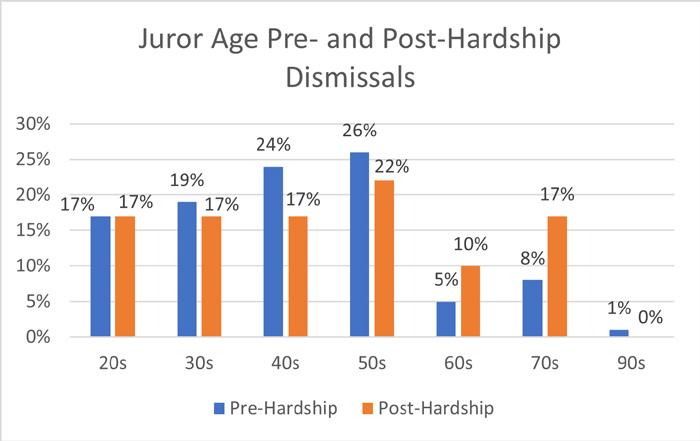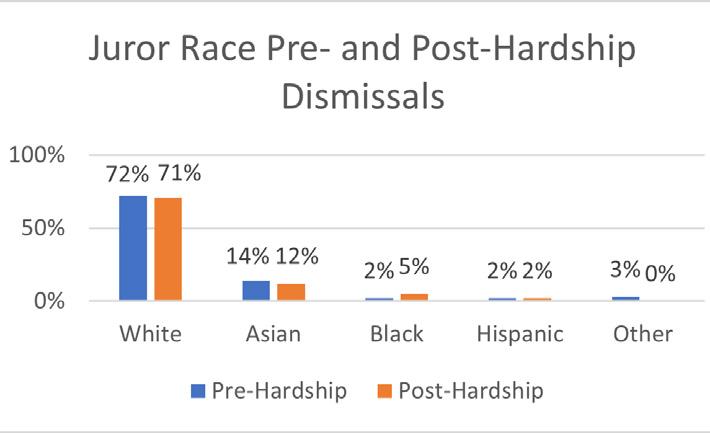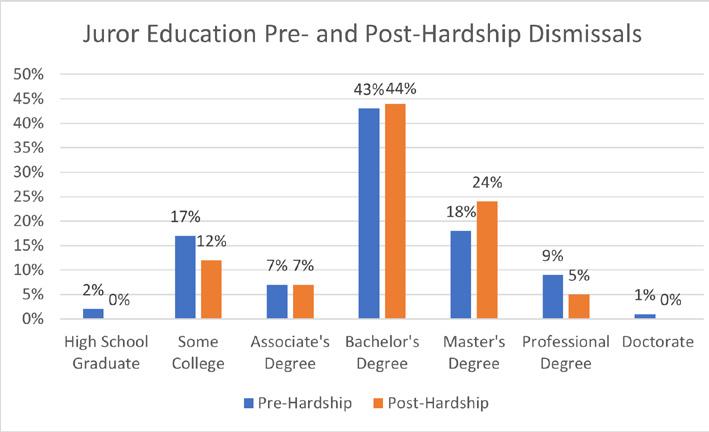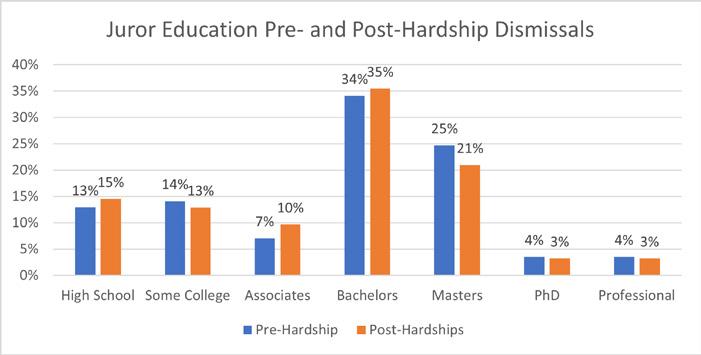
8 minute read
By Katrina Cook, Ph.D. • Litigation Insights
Juror Pool Composition Post COVID-19
In March of 2020, when the COVID19 pandemic first began to take hold in the United States, it was hard to imagine the extent to which this disease would change the fabric of American life. Common cultural touchstones that many took for granted suddenly became fraught with danger. Something as simple as going out to eat at a restaurant was no longer an option in many places. And the legal system was no exception. Across the country, jury trials abruptly slammed to a halt, as it was no longer safe to have groups of people congregate indoors for long periods of time. It has been nearly a year since that initial phase of lockdowns in the United States. And with a backlog of trials that only swells as time passes, many jurisdictions are desperate for measures that would allow jury trials to proceed. Some jurisdictions have begun conducting jury trials via electronic means, using videoconferencing software like Zoom. But this is not feasible in all areas and has the potential to exclude certain demographics, including older jurors and those of lower socio-economic classes, who may be unfamiliar with or unable to afford the technology required to participate in a virtual trial. Other venues have begun conducting in-person jury trials with appropriate social distancing policies in place. However, in-person trials bring their own unique set of concerns and anxieties to address. With all these obstacles to normalcy in place, clients express valid concerns about what to expect as they return to trial: How is COVID-19 affecting the composition of jury pools? How concerned are jurors about appearing for jury service? Will high-
Katrina Cook, Ph.D. Litigation Insights
risk groups, such as the elderly, be more likely to be dismissed due to health concerns? Having conducted a national survey on these issues and after assisting with some of the first jury selections in the country since the start of the pandemic, Litigation Insights has some preliminary answers to these important questions.
CONCERNS ABOUT COVID-19
One of the most discussed facets of the pandemic has been just how polarized the public’s response has been. Some individuals express little to no concern and have changed very little about their habits. Yet others say they are extremely worried and have cut off nearly all outside contact to mitigate the risk of the disease. In a May 2020 national survey conducted by Litigation Insights, 28% of potential jurors reported being very concerned about catching COVID-19, and another 36% indicated they were moderately concerned. However, 13% of jurors were not very concerned and 3% were not at all concerned. While these numbers show differing attitudes toward COVID-19 and have likely changed in recent months, it is clear that a significant number of jurors would potentially be concerned about the infection risks inherent in an in-person jury trial. Given the higher mortality risks for older individuals, one would expect concerns about COVID-19 complications to increase as juror age increases. Interestingly, in our survey, older individuals were significantly less concerned about complications from COVID-19, as compared to younger individuals. While lower anxiety around complications does not necessarily translate into older jurors being willing to serve during a pandemic, it does raise questions as to whether older jurors will truly be less represented on jury pools going forward. Although in-person jury trials have not yet been conducted frequently enough to examine this trend adequately, two recent case studies offer insight into how jury pools may be composed going forward.
CASE STUDIES REGARDING POSTCOVID JURY POOL COMPOSITION
In-person jury trials have resumed to a limited extent in some jurisdictions. In two such recent trials in a major metropolitan county, a comparison of juror demographics before and after the judges granted hardship excusals demonstrate interesting findings concerning how dismissals for COVID-19 fears may affect jury composition. In one trial, the demographics of which are shown in the charts below, jurors were asked if they would like to be dismissed due to concerns regarding COVID-19. Of the 89 total jurors initially in the pool, 26 requested dismissal due to COVID concerns. Of those 26 jurors, three were in their 20s, six were in their 30s, four were in their 40s, four were in their 50s, two were in their 60s, six were in their 70s, and one was in their 90s. An additional nine jurors requested dismissal due to concerns unrelated to COVID. When examining the pre-hardship jury pool, it should be noted that the values for some age groups are somewhat different than would be found in the total population pool for the jurisdiction. For example, according to the U.S. Census, individuals in their 60s represent approximately 13% of the jurisdiction’s population; however, in the initial pool
of reporting jurors, they represented only 5%. Overall, individuals in their 60s and 70s appeared at a rate somewhat lower than the population, while those in their 40s and 50s were slightly over-represented.
Interestingly enough, as shown in the following charts, the jury pool composition before and after hardship dismissals was not significantly different for any demographic. Further, contrary to what might be expected, juror attrition was higher for somewhat younger individuals, with the greatest loss occurring in the 40s age range. Indeed, although jurors in their 70s tied for the highest levels of requested hardships, older individuals still represented a larger percentage of the total jury pool following hardship dismissals, which had the added effect of drawing the percentages more in line with the overall population demographics. In fact, although older jurors expressed concerns regarding COVID-19, when ques-

JUROR AGE PRE- AND POST-HARDSHIP DISMISSALS
JUROR GENDER PRE- AND POST-HARDSHIP DISMISSALS

JUROR RACE PRE- AND POST-HARDSHIP DISMISSALS
tioned further, most indicated they were willing to serve despite those concerns. It is possible that those in their 60s and 70s with concerns were more likely not to appear at all, while those in their 40s and 50s with concerns responded to the jury summons, but then requested and received hardship dismissals. Ultimately, older individuals were not under-represented on the jury; indeed, the final seated jury in the case was comprised of six jurors over age 50.
The second trial in the jurisdiction revealed similar findings. First, it should be noted that the initial demographic pool was more in line with the overall population demographics, although there were slightly fewer individuals in their 40s than would be expected. Given that this trial took place nearly two months after the first trial, it is possible that older individuals with concerns are becoming more comfortable responding to a jury summons.
While fewer demographic markers were collected here, juror demographics for both education and age showed no significant differences between the pre- and post-hardship jury pool, although older jurors were excused at a slightly higher rate than younger jurors. Notably, however, unlike the previous case trial, dismissals were made on the basis of questionnaire responses only, so the attorneys were not afforded the opportunity to rehabilitate on the issue. Additional oral voir dire may have revealed that the jurors would have been comfortable serving despite their concerns, just as many had voiced in the first trial. Nevertheless, older jurors were still well represented in the final jury, which was comprised of 10 jurors over age 50 (including three in their late 60s and 70s).
JUROR AGE PRE- AND POST-HARDSHIP DISMISSALS GOING FORWARD
As these case studies suggest, the impact of COVID-19 on older jurors’ willingness to serve has not manifested. However, this data indicates some areas that should be considered going forward.
First, anxiety regarding COVID symptoms does not automatically translate into unwillingness to serve on a jury. While older individuals may recognize they are more at risk for complications from the virus, they are not necessarily more concerned about those complications than younger individuals. Nor are they inevitably more likely to be reluctant to participate in in-person jury service.
That said, if the goal is to preserve older jurors on the panel, who are often preferred by defendants in personal injury matters, then we recommend requesting further questioning for those who indicate they have hesitations regarding COVID-19. Had counsel in the first trial not requested additional questioning, several jurors would likely have been dismissed who would have been willing to serve. In particular, given the somewhat low initial percentage of individuals in their 60s and 70s who responded to the first trial summons, it was even more crucial that additional questioning helped retain those who were willing to look past their concerns.
FINAL THOUGHTS
COVID-19 has had a truly unprecedented effect on how the world conducts its daily life – and in many ways, we are still adapting to this new reality. As such, it will be important to continue to track and reflect upon how such changes affect the courtroom going forward. While these initial cases show promising results regarding older juror attrition, they also reveal some important actions we can take to help ensure post-pandemic jury pools truly reflect the population.
JUROR EDUCATION PRE- AND POST-HARDSHIP DISMISSALS



JUROR EDUCATION PREAND POST-HARDSHIP DISMISSALS

Dr. Katrina Cook a consultant with Litigation Insights has 11 years of practical application, study, and research in legal communication, jury research, and cognitive psychology. She has conducted and designed mock trials and experimental studies assessing juror attitudes toward the facts of a case and how other factors, such as attorney gender, may influence jurors’ judgments. Further, she has assisted counsel in implementing themes discovered during this research into their case argument.







